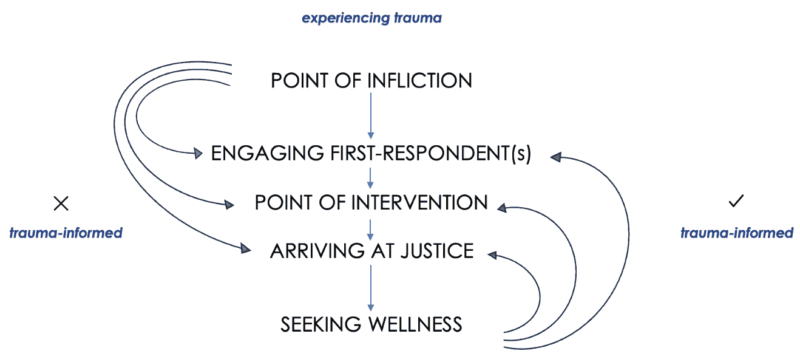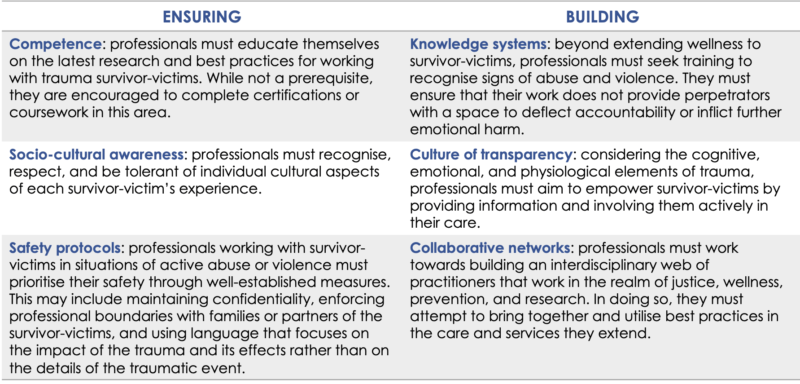ResourcesArticle
How to Shape a Trauma-Informed Approach for Better Organisational Outcomes
![]() 24th October 2023
24th October 2023

DESCRIPTION: AN ARTICLE ABOUT HOW GBV PRACTITIONERS AND RESEARCHERS CAN BE TRAUMA-TRAINED
Every case of sexual harm is also a case of trauma. Furthermore, every case of sexual harm brings with it the possibility of experiencing additional harm because:
- Trauma is not the experience of violence, but the experience of an individual’s prolonged response to violence. It is an emotional, physical, and cognitive response that affects one’s ability to regulate their emotions and responses on a daily basis.
- The lifecycle of a traumatic experience does not start and end at the first episode of violence or point of traumatic infliction. There are several respondents and stages involved during processes of handling, intervening into, or regulating a survivor-victim’s case and story. Here, lawyers, social workers, human rights activists, researchers, humanitarian workers, and healthcare professionals may inadvertently trigger past harm or cause future harm.
This is not to say that harm is inevitable. With the right training in trauma-informed practices, every professional can be empowered to accurately assess wrong-doing, engage in safe decision making, create interventions for rehabilitation, utilise ethical frameworks for social work, and centre survivor-victims in their justice and wellness.
Step 1: Understanding the Lifecycle of Trauma
After a traumatic incident has occurred, there are obvious, although not always accessible, next steps that a survivor-victim may take. They may:
- Engage First-respondent(s): this usually looks like seeking professional or personal care from people, organisations, and initiatives that are familiar and trustworthy. Members of their family, friends, peers, and colleagues act as informal first-aid providers. Internal complaint committees, support groups, legal and mental health professionals, reporters, and researchers act as formal first-aid responders. It then takes a community of aid to process harm and potentially take action.
- Locate Points of Intervention: this usually looks like taking action against perpetrators or enablers through professional intervention or activism. Here, affordable and dependable practitioners are invested to understand options for justice that minimise retaliation against seeking help. Community members may be engaged to start whisper campaigns and other security movements.
- Arrive at Justice: this usually looks like using aforementioned people and resources to fight for and accept outcomes of the methods of interventions selected. Traditional justice may not always, and rarely does in India, lead to favourable outcomes so survivor-victims may exhaust all avenues by choice or compulsion.
During each of these steps, given their interaction with factors and people beyond their control, survivor-victims are forced to stay on guard to minimise additional harm, re-traumatisation, and ineffective outcomes. Not only does it become important to select practitioners that are seasoned, come with reliable recommendations, and are affordable but also to only engage with them so long as their mental health allows them to.

Practitioners and community members then have the crucial opportunity to introduce wellness in each stage of their interaction with the survivor-victim. By creating a flow of wellness, one may interrupt a flow of unwitting harm infliction. Although how effectively individuals and organisations introduce wellness is determined by several factors, most of all being their level of trauma-informedness. So, it is paramount to adopt robust trauma-protocols that increase avenues for intervention, ability to intervene, and options for justice.
Step 2: Initiating Trauma Preparedness
To better understand how trauma manifests in the day to day, you may read more here. However, simply understanding and experiencing trauma does not build trauma-informed practices. Among other things, professionals must openly promote non-judgemental value systems, only offer vetted resources, build a holistic understanding of gendered violence and discrimination, and actively invest in making workplaces equitable. Failure to do so may allow prolonged or recurring harm to continue which in turn is a detriment to employee/survivor-victim wellness, productivity, and overall quality of life.
Therefore, at TCR, we believe it is important to:
- Set clear organisational goals that are reflected through the mission, vision, code of conduct, and hiring processes.
- Accurately gauge the preparedness of professionals that interact with survivor-victims. Assessing whether affiliate professionals are trauma-informed can involve, but is not limited to:

Step 3: Enforcing Trauma Preparedness
Trauma-informed practices are powerful. While goals for individuals may differ, it comes down to empowering survivor-victims with a new-found understanding of safety and continuity; one that is devoid of shame and isolation. This can create validating, encouraging, and committed spaces for the ones with whom we work. The ripple effect, in turn, can change the way we look at justice, recovery, and empowerment for survivor-victims. You may contact us to avail:
- Assessment modules for organisations to gauge the preparedness of social workers and health practitioners.
- Organisational training to facilitate trauma-informed socio-legal interventions.